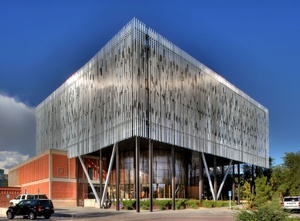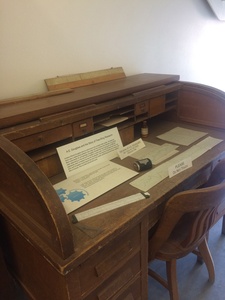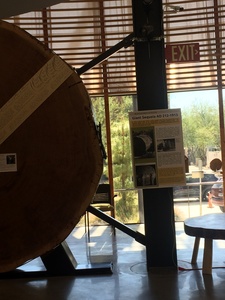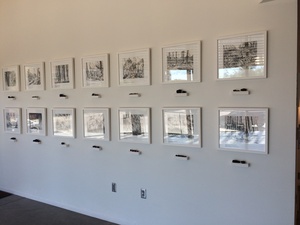The Laboratory of Tree-Ring Research at the University of Arizona is currently housed in the Bryant Bannister Tree Ring Building, erected in 2012. Previously, the LTRR archives and laboratory were housed under the west side of the Arizona Stadium as well as in Sunnyside School in South Tucson. Currently, the Bryant Bannister Building houses the LTRR's laboratories, office spaces, and other research based outlets, while the University's old Mathematics East building was surrounded by the newer Tree-Ring Building and then converted into the current Tree-Ring Archive with the rest of the Bryant Bannister Building in 2012, in order to house the laboratory's plethora of wood samples and tree-ring cores. The Bryant Bannister Building is located on the University of Arizona's Highland Commons, and is also accessible through Lowell St. adjacent to Park Ave.
 Bryant Bannister Tree Ring Building, University of Arizona.
Bryant Bannister Tree Ring Building, University of Arizona.
"Tree rings are a terrific way to learn about time, history and our world. From tree rings we learn about great natural and cultural events, such as droughts, forest fires, volcanic eruptions and the rise and fall of civilizations. You can actually see and touch centuries and millennia of history, all exactly ordered in the sequences of rings." - Thomas W. Swetnam, LTRR Laboratory Director and Regents' Professor of Dendrochronology
The Laboratory of Tree-Ring Research was founded in 1937, by the founder of modern dendrochronology, Andrew Ellicott Douglass. Douglass had been working with wood for 30 years prior to this establishment to find a connection between tree growth and sun spot cycles. Though Douglass was originally an astronomer, dendrochronology has become an interdisciplinary field for researchers worldwide. Upon further examination of tree-rings Douglass discovered that tree-ring growth largely depended on the amount of rainfall in a given year. Soon after, Douglass was also able to show that tree-ring growth signatures, due to rainfall, were consistent across the American Southwest for certain tree species. The fact that these certain tree species produced annual rings, allowed researchers to match the growth patterns of rings within a given area to create a chronology. Dating of tree samples then gave archaeologists an accessible form of absolute dating for Southwestern Archaeology, which has now been applied across the globe.
 The desk of A. E. Douglass, in the Bryant Bannister Tree-Ring Building's first-floor stairwell. (Photo by Klaudia Kendall)
The desk of A. E. Douglass, in the Bryant Bannister Tree-Ring Building's first-floor stairwell. (Photo by Klaudia Kendall)
The LTRR is particularly known for their involvement in the study of dendrochronology. This study has been leading the advancement of dating methods for ancient wood found during archaeological excavations.Dendrochronology is the study of tree-rings in order to date historical events, climate changes, or other potential factors that have effected tree-ring growth during a certain year. Often, one year is associated with one tree ring. However, the Laboratory of Tree-Ring Research utilizes radiocarbon dating as well as other cross-dating techniques to ensure an accurate dating of these wood samples for study. The LTRR has since expanded their horizons, and now does extensive work regarding dendroarchaeology, fire histories, dendrogeomorphology, dendroecological studies, as well as dendroclimatology. Though the LTRR is no longer the world's only dendrochronology lab, it is the oldest, and the Laboratory of Tree-Ring Research in Tucson has been a distinct force in founding other worldwide labs of tree-ring research. The LTRR strives to be at the forefront of dendrochronology worldwide, and "makes significant contributions to understanding natural environmental variability in climatic, hydrologic, geomorphic, and ecological systems".
 Ancient, dated Sequoia Cross-Section in the Bryant Bannister Building Lobby (Photo by Klaudia Kendall)
Ancient, dated Sequoia Cross-Section in the Bryant Bannister Building Lobby (Photo by Klaudia Kendall)
Visitors to Tucson as well as Tucson residents are welcomed into the Laboratory of Tree-Ring Research through outreach events as well as docent led tours of the Bryant Bannister Tree-Ring Building, where visitors are given a crash course in dendrochronology and the history of dendrochronological studies. The outreach program at the LTRR includes resources for educators, students, and other visitors in order to facilitate new connection and nurture existing connections to the greater Tucson community. These outreach events put on by the Laboratory of Tree-Ring Research include dendrochronology classes for elementary, middle school, and high school students, art classes where visitors can create their own textile-based tree rings, tours of the building for the capable and handicapable, and field study classes for those interested in the collection of wood samples. Some outreach events are created as an outlet for donations to the Laboratory of Tree-Ring Research. Due to COVID-19 precautions, docent led tours and outreach events were cancelled from February 2020 through June 2021.Docent led tours are free, and are available to the public:
- Every Tuesday of the month: (August through May) from 10AM to 11AM.
- Every 1st and 3rd Wednesday of the month: (August through May) from 10AM to 11AM.
- Tour requests must be sent to [email protected] or 520.621.0984 in advance.
Docent tours are operating under limited capacity due to COVID-19 mitigation policies.
Ashes to Ashes display in the Bryant Bannister Building Lobby (Photo by Klaudia Kendall)
The Laboratory of Tree Ring Research takes their connection to the Tucson community very seriously. Besides their outreach and other visitor-based events, the Tree-Ring Lab gives an Open House tour to those attending the Tucson Festival of Books as a community outreach event in March or April of every year. Tree-Ring day is also celebrated for both faculty and visitors with talks from students and employees of the Tree-Ring Lab within the Bryant Bannister Building. "Outreach activities can include scientists visiting schools, giving talks at assemblies, discussions with students, or participation in events such as career fairs and science and technology camps." Though the Archive is not open to the public, often pieces from the Tree-Ring Archive are temporarily given to the outreach program and director so visitors can see new samples being used to build chronologies, sample ecological histories, and examine more closely the science of tree-rings. Community events and outreach programs are headed by Pamela Pelletier.
In 2015, the Laboratory of Tree Ring Research also created a collection of charcoal based artwork entitled Ashes to Ashes by artist Julie Comnick, for the Southwest Fire Consortium's display entitled Fires of Change. Ashes to Ashes is a series of drawings depicting recent Arizona wildfires, rendered with charcoal samples personally collected from each fire site. Each drawing is displayed with its corresponding charcoal sample. The collection represents fourteen significant wildfires from 1990 to the present, with archived photographs used as references. The display was housed in the University of Arizona Museum of Art from November 2015 until early April of 2016. The Ashes to Ashes collection was on display in the LTRR lobby from 2017-2018. More work by Julie Comnick can be found athttp://juliecomnick.com/



